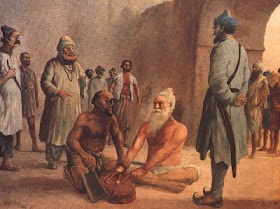Bhai Mani Singh Shaheed (martyr) (1670 - 9 July 1737), a great Sikh personality of the eighteenth century, occupies a very esteemed position in Sikh history, when he assumed the control and steered the course of the Sikhs' destiny at a very critical stage. A great scholar, a devoted Sikh, and a courageous leader, Bhai Mani Singh willingly laid down his life to uphold the dignity of the Sikh religion and the Sikh nation. The nature of his martyrdom has become a part of the daily Sikh Ardas (prayer).
Birth
There is some uncertainty about the exact year of birth of Bhai Mani Singh. Giani Thakur Singh writes his year of birth as 1672 while some other writers put it at 1670, but according to Sohan Singh Seetal, a well known Sikh historian, Bhai Mani Singh was born in 1664. Principle Satbir Singh listed his year of birth as 1672 in his 1970 edition of his, "Sada Itihaas"', but changed it to 1662 in the later editions. . According to Dr Santokh Singh also, Bhai Mani Singh was born in 1662 . These earlier dates are indirectly based on Giani Giani Singh's references to ninth Guru's visit to village Akoi/Malwa in year 1665. Based on critical analysis of ancient Sikh writings, it appears that Bhai Mani Singh may have been born no later than 1665.
In the service of the Guru
Bhai Mani Singh is said to have been brought in the early years of his childhood to the presence of Guru Tegh Bahadur at Anandpur. He was not the same age as the Guru's own son, Gobind Rai. Mani Singh remained in his company even after he had ascended the religious seat as Guru. Mani Singh accompanied the Guru to the seclusion of Paonta where Guru Gobind Singh spent some three years in large part given to literary work.
Bhai Mani Singh took Amrit at the hands of Guru Gobind Singh Ji on the day of the creation of Khalsa. When Guru Gobind Singh Ji left Anandpur on the night of December 20, 1704, his family got separated at river Sirsa during the confusion created by the Mughal attack. Bhai Mani Singh took Mata Sundri Ji and Mata Sahib Devan to Delhi via Ambala.
In 1706, Bhai Mani Singh escorted Mata Sundri Ji the wife of Guru Gobind Singh to Talwandi Sabo where the Guru was staying. It was there that she learned of the Martyrdom of her four sons and their Grandmother. When Guru Sahib left Agra with Emperor Bahadur Shah for Nanded in 1707, Mata Sahib Devan and Bhai Mani Singh accompanied him. Afterwards Bhai Mani Singh escorted Mata Sahib Devan Ji back to Delhi where she lived with Mata Sundri Ji for the rest of her life.
Mata Sundri Ji came to know of the trouble that was brewing between the Tat Khalsa and Bandai Khalsa military factions of the Sikhs. She appointed Bhai Mani Singh as the Granthi of Harimandir Sahib and sent him to Amritsar with Mama Kirpal Singh (Chand), the maternal uncle of Guru Gobind Singh Ji. On his arrival at Amritsar in 1721, Bhai Mani Singh restored peace among the Khalsa and put the affairs of Harimandir Sahib in order.

The Mughal Empire
By 1737, the Mughal government of Lahore had strictly prohibited the Sikhs to visit Amritsar and bathe in the holy tank. To overcome this restriction, Bhai Mani Singh applied to Governor Zakariya Khan for permission to hold the Diwali festival at the Golden Temple. The permission was granted for a promised payment of Rs.5,000 to the Governor. Bhai Mani Singh was certain that he would be able to pay the sum out of the offerings that would be made by the Sikhs who were invited to come.
The Sikhs came in large numbers, but Zakariya Khan, under the pretext of keeping order, sent a force under Diwan Lakhpat Rae to Amritsar. It marched towards the city on the day of the festival in order to intimidate and disperse the Sikhs and the festival broke up at the approach of the Mughal army.
Execution
Bhai Mani Singh was arrested for not paying the stipulated sum. He was asked by the Qazi to embrace Islam or else face death. Bhai Mani Singh stoutly refused to barter his faith and boldly opted for death. By orders of Zakarya Khan, Bhai Mani Singh was executed at Nakhas, Lahore in December, 1737 AD. The Nakhas has since been known as Shaheed Ganj - the place of martyrdom .
This was a gruesome execution in which Bhai Mani Singh's executioner was ordered to chop Bhai Mani Singh's body to pieces joint by joint starting from the extremities. The irony of the execution was that Bhai Mani Singh had the last word. When the executioner started to cut into Bhai Mani Singh's wrist, Bhai Mani Singh gestured to his fingers telling the executioner that he should follow the orders of his commander with strictness, like a true Muslim. Very puzzled by the interruption, the executioner and guards asked the Great Shaheed what he meant. Bhai Mani Singh replied, " you have been ordered to execute me by chopping my joints, have you forgotten that my joints start with my fingers.
No comments:
Post a Comment
REQUEST IF YOU FIND ANY MISTAKE. PLEASE TELL US.